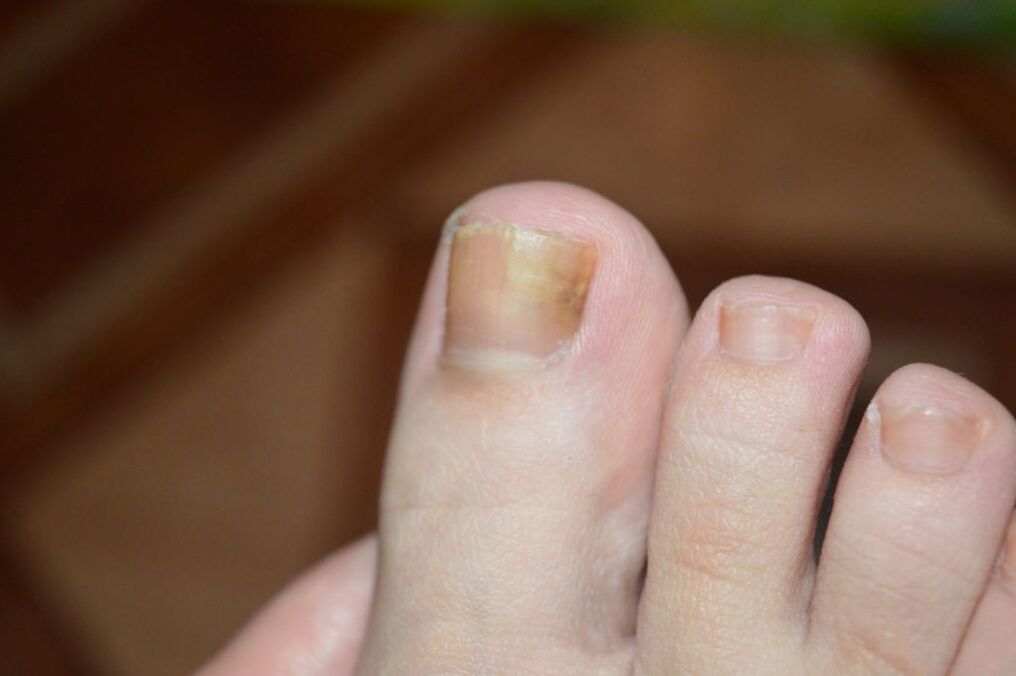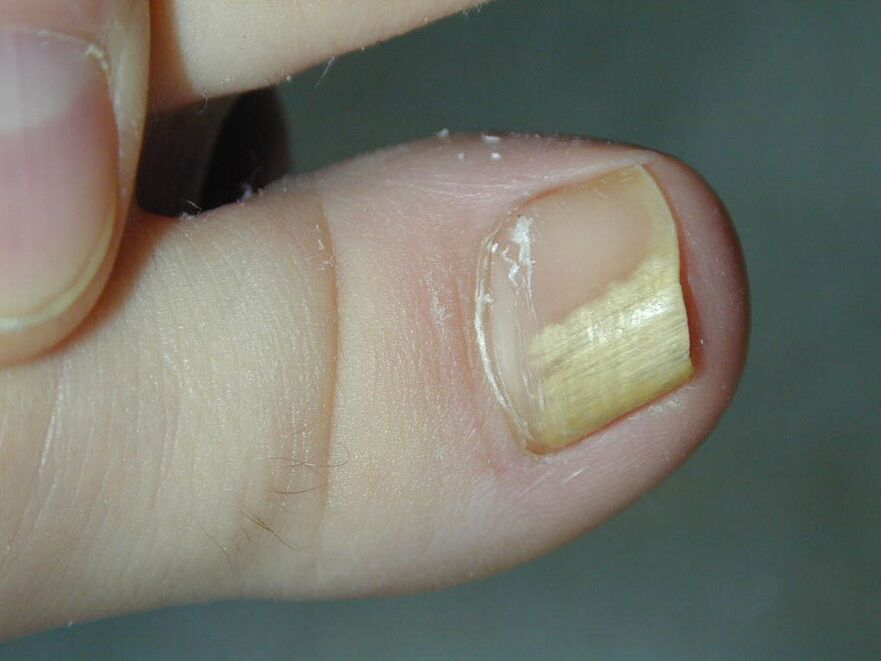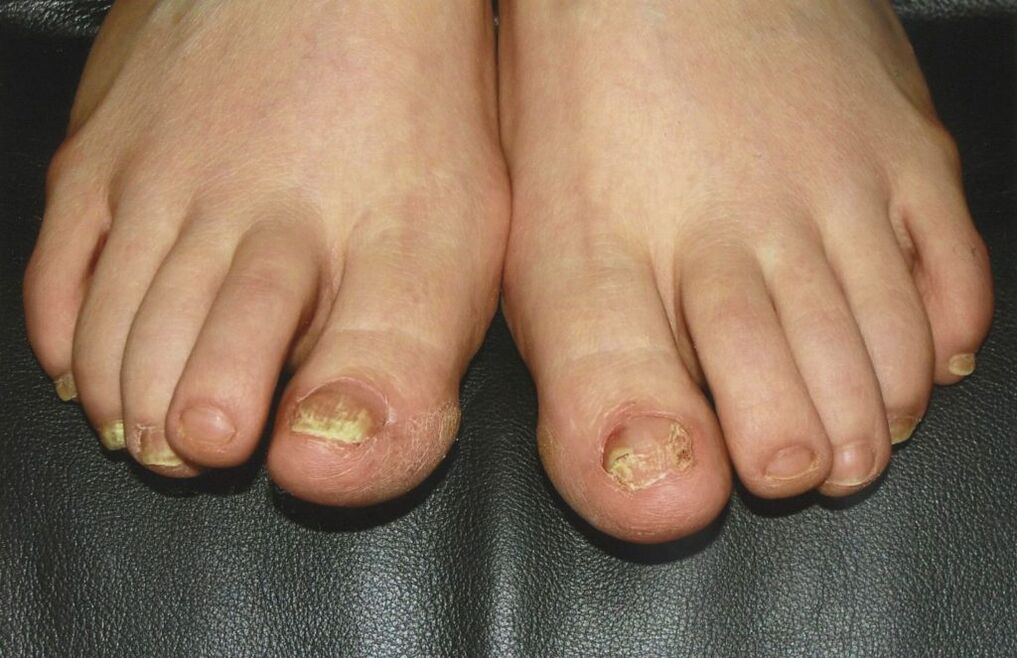
Among the most common dermatological diseases, doctors specifically isolate a fungal infection. Due to the fact that the clinical picture of this disease is poorly expressed, many do not take it seriously. In fact, onychomycosis can lead to loss of nail plates and even sepsis.
This is the main reason why the treatment of nail fungus should be started at the initial stage. It is extremely important to use special antifungal agents prescribed by a specialist.
The main symptoms of the fungus
The clinical picture of this disease has been very well studied. This makes it easy to identify the symptoms of nail fungus on the hands and feet, regardless of its stage.

The main ones are as follows:
- The nail changes color, turns yellow or green. In some cases, it can acquire a white and brown color. There are even cases when the nail plate turns multi-colored;
- Severe itching is felt on the skin near the nail plates;
- The skin becomes inflamed, redness is noted in it;
- The nail changes structure, thickens or thins;
- Peeling of the skin;
- Deformation of the nails;
- The nail plates become brittle;
- Detachment of nails.
What does nail fungus look like and its first symptoms
At the very beginning, the disease does not have pronounced symptoms, the deformation of the nails during this period is not observed at all.

At the initial stage, nail fungus is manifested by the following symptoms:
- Dry skin;
- Itching;
- The soft tissues around the nails turn slightly red;
- Slight discoloration of the nail plates;
- The nails do not shine, less elastic;
- The appearance of corns.
At this stage of the disease, patients often do not notice changes in the nail plates, which prevents them from seeing a doctor in time. That is why it is extremely important to know exactly what nail fungus looks like in order to start treatment as soon as possible. After all, it is during this period that the pathology is easiest to treat.
Important!
If we talk about the appearance of the fungus on the nails of the hands at the initial stage, then the symptoms are as similar as possible to those that occur when the nail plates of the legs are affected.
Methods of diagnosing nail fungus
It is quite difficult to diagnose the initial stage of nail fungus. This will require a number of additional studies. This is mainly due to the fact that the symptoms are poorly expressed.
Among the necessary analyzes, we distinguish:
- Clinical blood test. With his help, the specialist receives information on whether the reaction of the body to the inflammatory process provoked by microorganisms is observed;
- General urine analysis. Although this study only provides information on the general state of health of the patient, it can also be used to identify concomitant pathologies of the urinary system;
- Examination of the tissue of the nail plates under a microscope. This method manages to determine not only the presence of the fungus, but also its variety;
- Blood chemistry.
A dermatologist must correctly decipher the results of the research. If at the first signs of the disease a person turns to a therapist, in the near future he will certainly still be referred to a restricted specialist. After all, he is the one who knows what nail fungus looks like on the hands and feet and, therefore, will be able to correctly diagnose.
How to treat toenail fungus
Fungal diseases are treated exclusively under the supervision of a doctor. Before prescribing treatment, a specialist takes into account a number of factors:
- The degree of damage to the nail plates;
- The form of the disease;
- The stage of redness of the skin;
- The degree of deformation of the nails.
At the stages when onychomycosis is just beginning to develop, it will be enough to use only local drugs. Special antimycotic varnishes, solutions and gels are applied to the affected areas immediately after the treatment of the affected nails by a surgical or keratolytic method. After this simple procedure, the drugs are absorbed better, and as a result, the treatment is carried out much faster.
Keratolytics contribute not only to the softening of the nail plates, but also to the painless removal of the affected areas. This procedure is performed using conventional patches containing urea or salicylic acid.
The application of this patch must be carried out according to the following scheme:
- The surface of the nail plates is carefully scraped.
- A special composition is applied to the affected nails.
- The mass is sealed with an adhesive bandage.
- The dressing is changed once a day, a maximum of two.
- Plates damaged by the fungus are cut off.
- The antifungal agent is applied immediately.

The patch should be changed every day before going to bed.
There are a number of other external drugs that are effective in the fight against nail fungus.
If the stage of the disease is already significantly advanced, then the specialist can prescribe antimycotic drugs, which should be taken orally. The same funds are needed in the early stages, but only if local therapy has not given any results.
Important!
You cannot prescribe antifungal drugs for yourself. Only a specialist can choose the most effective and safe remedy, prevent the further development of the disease and the appearance of relapses.
Preventative measures
Nail fungus is an infectious disease. Thus, in order to avoid it, certain precautions must be taken:
- Maintain personal hygiene;
- Use only personal effects when visiting the swimming pool or the bath;
- Do not try on someone else's shoes on an unprotected leg, be sure to wear a sock;
- Be as careful as possible when in contact with someone already infected with the fungus;
- Avoid contact with animals infected with the fungus.
It is important to remember that nail fungus is not a harmless disease at all. Its initial stage does not cause anxiety in the majority. This is why the disease is more and more common. It is necessary to monitor the condition of the nail plates and the tissues adjacent to them, at the first manifestations of the disease, seek help from a specialist.
From the early stages of this disease is very easy to cure. If you run it, very unpleasant consequences are not excluded.
















